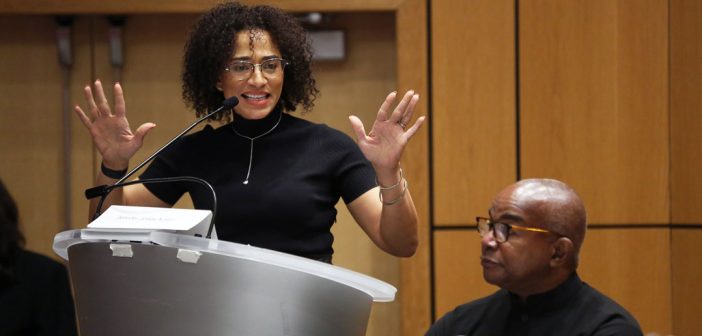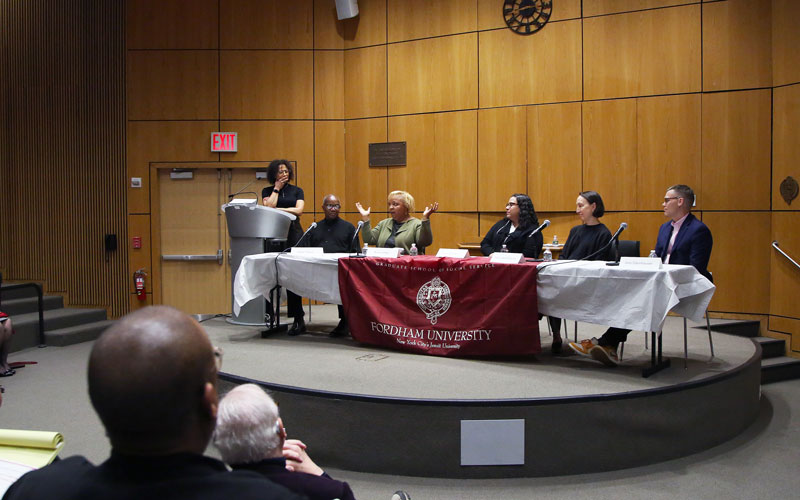The symposium, titled “Leading for Change: How to Create Sustainable Impact in Children and Family Services,” brought together agency leaders, government officials, service providers, and more to learn about how partnerships can improve care and how the system can work to confront challenges.
Anne Williams-Isom, FCLC ’86, New York City deputy mayor for health and human services, helped organize the symposium to provide a place for professionals to learn with and from each other. While Williams-Isom was unable to attend, she said that the idea for the forum came from the legacy of James Dumpson, the late activist and leading social crusader who served as the city’s first black welfare commissioner and as GSS dean from 1967 to 1974.
“So much of Dr. Dumpson’s work was about the intersection of policy, practice, and research—he wanted to ensure that NYC children, families, individuals, and communities were supported with dignity,” said Williams-Isom, who served in leadership positions in the city’s child welfare system for many years before going on to lead the Harlem Children’s Zone, an education and anti-poverty nonprofit.
John Mattingly, a former head of New York City Administration for Children’s Services (ACS), encouraged those in attendance to value the importance of public service.
“Public service creates public value,” he told those in attendance. “The work that we highlight tonight is one example of public service going back into the mid 1990s. And still going on here in New York City as we speak.”

Shirley Gatenio Gabel, the Mary Ann Quaranta Endowed Chair at GSS, served as the moderator for a panel.
A Look Back
Mattingly, who served as the welcome speaker, set the stage for the first panel, which featured a look back at the history of ACS. The panel included Linda Gibbs, who served as deputy mayor for health and human services for New York City; Gerard McCaffery, the former president and CEO of MercyFirst, a nonprofit human and social service agency; Sister Paulette LoMonaco, formerly of Good Shepherd Services; and Fred Wulcyzn, the director of the Center for State Child Welfare Data, Chapin Hall, at the University of Chicago.
Shirley Gatenio Gabel, the Mary Ann Quaranta Endowed Chair at GSS, who served as the moderator, highlighted the strides that many of the panelists had made during their time working with or for the city.
“There’s one statistic that keeps on coming to mind—in 1996, when ACS was founded, there were 50,000 children in care, and today, there’s 6,800,” she said. “So I think we can all agree that’s 6,800 too many children in care, but what an accomplishment. And a lot of that accomplishment is due to the hard work of people on this panel and people in this room, and many others working together to create a new system for children.”
The Importance of Data
Wulcyzn said he’s seen how data and story collection from those in the system can help to make improvements. He has about 4.5 million records of children in foster care since the late 1970s, when they first started tracking children’s experiences—at the time on index cards, compared to today’s more modern, efficient system.
“In the last 45 years or so, we have completely changed [the system], and our ability to know something that was happening to children is extraordinary,” he said. “And at the time with Linda and Nick [Scoppetta, the first head of ACS] and all the people who worked at ACS at that time, it was the first time we really had a chance to demonstrate what could be done to take those stories seriously and use them to make a better system.”
Addressing Current Issues
While panelists acknowledged that progress had been made in serving children and families, the second panel of the evening highlighted some of the challenges that still need to be addressed. The panel featured Jess Dannhauser, the current ACS commissioner; Julia Jean-Francois, the co-executive director at the Center for Family Life; Benita Miller, the executive director of Powerful Families, Powerful Communities; Raysa Rodriquez, chief program and policy officer at Federation of Protestant Welfare Agencies; and Willie Tolliver, professor at the Silberman School of Social Work at Hunter College.
Jennifer Jones Austin, LAW ’93, the CEO of the Federation of Protestant Welfare Agencies, an anti-poverty, policy, and advocacy organization, served as the moderator. She said that as she listened to the speakers from the first panel, she kept thinking of the word sankofa, which is an African word from a tribe in Ghana.
“The literal translation of the word sankofa is ‘it is not taboo to fetch what is at risk of being left behind,’” she said. “What it means is taking from the past what is good and bringing it into the present to make progress in the future.”
Jones Austin said that she saw this as the goal of the evening—to look back on the history of ACS and to engage in “constructively critical analysis” of child welfare.
Miller said one of the things the agencies should keep in mind as they continue this work is the need to keep the community and the voices of children at the center of it..
“For me, it was very, very important to bring in folks who were impacted by the system to the conversations that were happening around their lives,” she said.
Inequities and Underlying Causes
Jones Austin emphasized that the system is set up to “treat the symptom.”
“To solve the problem, we have to get at the underlying cause that created the problem in the first place,” she said, citing examples of structural inequities such as poverty, mass incarceration, economic deprivation, social and emotional well-being, and a lack of clinical resources in communities. “We’re not going to solve these problems by just pouring more money into systems that are in place, at best, to treat the system.”
Dannhauser also highlighted the disparities that he and his team are working to address.
“There’s disproportionality throughout the entire system—the most disparate point is at the point of the call,” he said. “It’s 6.6 times more likely that a Black family be called [into ACS]than a white family in New York City. That means, according to one study, that we are investigating almost half of Black families in New York City—44%. And that’s something we’re working really hard on to fix.”
One way is through providing families with resources upfront, he said.
“We have a lot of work to do around how we engage families. We are very open in this administration that it may not be right for ACS to be building all of the solutions, but that there should be other areas that are created, and we have a long way to go.”
Williams-Isom said the goal of the forum was to focus on “how to create sustained reforms over many years in children and family services.”
“The panelists demonstrated the power of diverse teams to bring about systemic change and large-scale reform,” she said in an email following the event. “This needs to happen throughout the entire human services system so that we can reimagine what is possible so that people can truly thrive. I am so proud that Fordham GSS is at the center of this very important work.”




